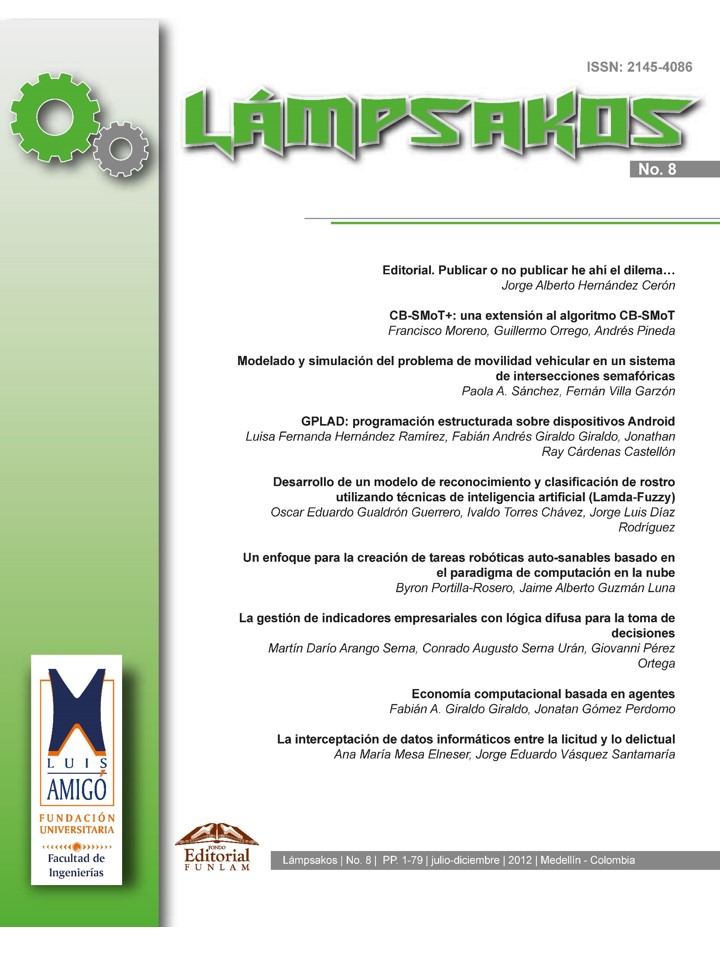GPLAD: Programación Estructurada Sobre Dispositivos Android
DOI:
https://doi.org/10.21501/21454086.675Keywords:
Programación por bloques, Lenguajes, Traductor,Abstract
La programación por medio de bloques es un enfoque visual que permite a las personas jóvenes adquirir interés en el desarrollo de software. Así lo han demostrado herramientas para computadores como Scratch, StarLogo y Alice. Hoy en día hay estudiantes e ingenieros programadores que desean implementar soluciones más estructuradas y hay pocas herramientas que, a través de programación gráfica ofrezcan la posibilidad de solucionar problemas que se manejen en primeros semestres universitarios. Por otro lado, los dispositivos móviles, en especial los que poseen sistema operativo Android, han tenido acogida en los últimos años, además, son utilizados para resolver problemas en tiempo real. El objetivo de este trabajo fue demostrar la utilidad de una aplicación que soporta la programación estructurada por medio de bloques sobre dispositivos Android, que facilita la creación y ejecución de código en el lenguaje Java sobre un servidor remoto. Se realizó un análisis para determinar el ambiente de programación, la creación de bloques con su representación intermedia y las validaciones para la generación de código, además, se realizaron pruebas a través de la formulación de problemas matemáticos que se enseñan durante los primeros cursos de Ingeniería de sistemas en la Fundación Universitaria San Martín. Finalmente, se obtuvo el código Java de la solución a cada problema planteado dentro de Gplad.Downloads
References
Aradas, A. La programación de computadoras es “el latín del siglo XXI”. Disponible en: . Acceso: 13 Abr. 2012.
Johnsgard, K. & McDonald, J. (2008). Using Alice in overview courses to improve success rates in programming I. 8.
Kelleher, C; Pausch, R. Lowering the Barriers to Programming: a survey of programming environments and languages for novice programmers, tech. report CMU-CS-03-137, School of Comp. Science, Carnegie Mellon, 2003.
Xiajian, C.; DANLI, W.; HONGAN, W. Design and Implementation of a Graphical Programming Tool for Children. IEEE International Conference on Computer Science and Automation Engineering - CSAE, 2011, p. 572-576.
Mohamad, H.; Patel, A.; Latih, R.; Qassim, Q.; Na, L. Y. Tew. Block-based Programming Approach: Challenges and Benefits, Conference: International Conference on Electrical Engineering and Informatics – ICEEI, pp. 1-5, 2011.
Wang, K.; McCaffrey, C.; Wendel, D.; Klopfer, E. 3D Game Desing with Programming Blocks in StarLogo TNG. In ICLS: Proceedings of the International Conference on Learning Sciences. International Society of the Learning Sciences. 2006. p.1008-1009.
APPFOUR GMBH. (2012). Recuperado el 6 de agosto de 2012, de AIDE - Android Java IDE: https://play.google.com/store/apps/ details?id=com.aide.ui&hl=es
Catroid. Recuperado el 24 de febrero de 2013, Obtenido de http://www.catroid.org/catroid/index/ 1
Cárdenas, J. R. Dsl Gráfico para la solución de problemas de programación sobre dispositivos móviles Android. 2011. 151 p. Monografía (Ingeniería de Sistemas). Fundación Universitaria San Martín, Bogotá, 2011.
MIT. StarLogo TNG. Recuperado el 19 de octubre de 2012, de http://education.mit.edu/projects/ starlogo-tng
JADE. Java Agent Development Framework. Disponible en: < http://jade.tilab.com/>, Acceso 25 de Agosto de 2012.
Maloney, J. et al. The Scratch Programming Language and Environment. ACM Transactions on Computing Education, New York, vol. 10, n. 4, p. 1-15, Nov. 2010.
Apóstol, T. (2012). Introducción a la teoría analítica de números. Editorial Reverté. p. 19.
Downloads
Published
How to Cite
Issue
Section
License
In accordance with national and international copyrights, as well as publishing policies of "Fundación Universitaria Luis Amigó" and its Journal "Lámpsakos" (indexed with ISSN : 2145-4086), I (we ) hereby manifest:1. The desire to participate as writers and submit to the rules established by the magazine publishers.
2. The commitment not to withdraw the manuscript until the journal finishes the editing process of the ongoing issue.
3. That article is original and unpublished and has not been nominated or submitted together in another magazine; therefore, the rights of the article in evaluation have not been assigned in advance and they do not weigh any lien or limitation for use.
4. The absence of conflict of interest with commercial institution or association of any kind
5. The incorporation of the quotes and references from other authors, tending to avoid plagiarism. Accordingly, the author affirms that the paper being published do not violate copyright, intellectual property or privacy rights of third parties. Morover, if necessary there is a way of demonstrating the respective permits original copyright to the aspects or elements taken from other documents such as texts of more than 500 words, tables, graphs, among others. In the event of any claim or action by a third party regarding copyright on the article, the author (s) will assume full responsibility and come out in defense of the rights herein assigned. Therefore, for all purposes, the Journal "Lámpsakos" of the "Fundación Universitaria Luis Amigó" acts as a third party in good faith.
6. In the event of the publication of the article, the authors free of charge and on an exclusive basis the integrity of the economic rights and the right to print, reprint and reproduction in any form and medium, without any limitation as to territory is concerned, in favor of the Journal "Lámpsakos" of the "Fundación Universitaria Luis Amigó".








